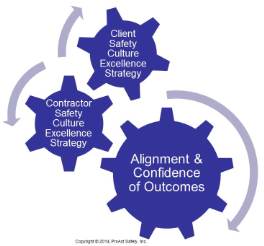Client and Contractor: Aligning Safety Cultures
Organizations serious about safety excellence focus on long-term value for both employees and contractors and place quality of life over cost reduction.
Conducive cultures can be the most effective tool in achieving safety results. High-performance organizations realize alignment of safety cultures is becoming the core responsibility of not just the contractor, but those engaging them, as well.
In this time of strategic outsourcing, many companies utilize contractors to support various business operations. Whether short- or long-term, these contractors are a business necessity in several companies. As these organizations bring groups together representing different cultures around safety, new risks emerge. How well the cultural risks are identified and mitigated and desired beliefs and behaviors are improved will be the new competitive advantage in safety performance.
In your organization, are contractors being held accountable for maintaining certain incident rates or what they do to achieve them? When contractors are selected, is it determined how well their culture would match and complement the company's culture or is more emphasis placed on whether they have the right programs in place? Is there uniformity in safety practices or are there different expectations for contractors and employees? How well aligned are the company and contractor safety excellence strategies?
 Organizational culture can be either a powerful tool or a hindrance to the results organizations need from their contractors. A contractor's culture not only influences the beliefs and behaviors of their employees, but also the client's employees. When the behavior of contractor personnel is observed by client employees, over time, this has an impact on the beliefs, decisions, and behaviors of client employees and the stories they tell one another. With recent unfortunate media-worthy events, it is hard to argue with the fact that contractor and client cultures affect each other.
Organizational culture can be either a powerful tool or a hindrance to the results organizations need from their contractors. A contractor's culture not only influences the beliefs and behaviors of their employees, but also the client's employees. When the behavior of contractor personnel is observed by client employees, over time, this has an impact on the beliefs, decisions, and behaviors of client employees and the stories they tell one another. With recent unfortunate media-worthy events, it is hard to argue with the fact that contractor and client cultures affect each other.
Organizations leveraging contractors require a culture-conversation framework that initiates dialogue with both short- and long-term contractors, creating clarity around what safety excellence looks like in knowledge, beliefs, and behaviors, not just results. Safety roles, responsibilities, and results need to be collaboratively developed and a positive and proactive accountability system established to influence and achieve excellence in outcomes.
Several client organizations have deployed methodologies to mutually influence safety cultures (theirs and their contractors) with great success. An energy client based in the United Kingdom modified their entire approach to contractor selection and management following the results of an 18-month pilot project in 2010-2011. Post-project contractors privately reported to ProAct Safety it was the most successful and enjoyable project they had been a part of. Interestingly, this has contributed to a recognition among the construction firms the client typically employs as becoming one of the most desirable clients to work with. One such contractor stated, "We all have clients that are serious about safety but demonstrate it by increasing ridiculous rules and punishment. They demonstrate it by showing they care about our people as much as we do."
Organizations serious about safety excellence focus on long-term value for both employees and contractors and place quality of life over cost reduction. Further, they take steps to ensure alignment between not just safety activities, but also the different cultures they reside within. With an effective strategy for safety excellence that leverages data (e.g., injury, incident, risk, and cultural) to prioritize objectives, the correct initiatives that execute against them, and a balanced scorecard to track progress and results, performance and cultures can be considerably enhanced and aligned between organizations.
Progress will begin with good communication; respectfully challenging status-quo thinking; believing there will always be a better way; a willingness to identify both the future desirable and current reality of safety perceptions, decisions, behaviors, experiences, and stories; and working collaboratively to prioritize and close the gaps. Having a strategic framework in place that establishes accountability for culture, not just activities and results, is essential for continuous improvement in business results, but the most important element is the lives of the people involved, on and off the job.
This article originally appeared in the October 2014 issue of Occupational Health & Safety.
About the Author
Shawn M. Galloway is the president of ProAct Safety and co-author of several best-selling books. As a consultant, advisor, and keynote speaker, he has helped hundreds of organizations within every major industry to improve safety strategy, culture, leadership, and engagement. He is also the host of the acclaimed weekly podcast series Safety Culture Excellence®. He can be reached at 936-273-8700 or info@ProActSafety.com.